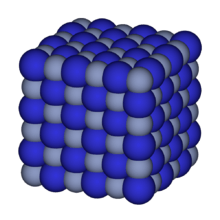Chromium nitride
Chromium nitride is a chemical compound of chromium and nitrogen with the formula CrN. It is very hard, and is extremely resistant to corrosion. It is an interstitial compound, with nitrogen atoms occupying the octahedral holes in the chromium lattice:[2] as such, it is not strictly a chromium(III) compound nor does it contain nitride ions (N3−). Chromium forms a second interstitial nitride, dichromium nitride, Cr2N.
 | |
| Names | |
|---|---|
| IUPAC name
Chromium nitride | |
| Other names
Chromium(III) nitride | |
| Identifiers | |
3D model (JSmol) |
|
| ChemSpider | |
| ECHA InfoCard | 100.041.819 |
| EC Number |
|
PubChem CID |
|
| UNII | |
| |
| |
| Properties | |
| CrN | |
| Molar mass | 66.003 g/mol |
| Appearance | Black powder |
| Density | 5.9 g/cm3 [1] |
| Melting point | 1770 ˚C (decomp.)[2] |
| Insoluble[3] | |
| Thermochemistry | |
Std molar entropy (S |
37.75 J K−1 mol−1 [4] |
Std enthalpy of formation (ΔfH⦵298) |
−117.15 kJ/mol [4] |
| Hazards | |
| Flash point | Non-flammable |
| NIOSH (US health exposure limits): | |
PEL (Permissible) |
TWA 1 mg/m3[5] |
REL (Recommended) |
TWA 0.5 mg/m3[5] |
IDLH (Immediate danger) |
250 mg/m3[5] |
| Related compounds | |
Related compounds |
Dichromium nitride |
Except where otherwise noted, data are given for materials in their standard state (at 25 °C [77 °F], 100 kPa). | |
| Infobox references | |
Synthesis
Chromium(III) nitride can be prepared by direct combination of chromium and nitrogen at 800 °C:
- 2 Cr + N
2 → 2 CrN
It can also synthesize by Physical Vapour Deposition technique such as Cathodic arc deposition.
Applications
CrN is used as a coating material for corrosion resistance and in metal forming and plastic moulding applications.[6] CrN is often used on medical implants and tools. CrN is also a valuable component in advanced multicomponent coating systems, such as CrAlN, for hard, wear-resistant applications on cutting tools.[7]
Magnetism
The fundamental materials physics of CrN, giving rise to its favorable properties, has been debated recently in high-profile scientific journals such as Nature Materials.[8][9] In particular, the importance of magnetism in both the low temperature and the high temperature phases has been demonstrated by means of quantum mechanical calculations of the electronic structure of the compound.[10][11][12]
Natural occurrence
Though rare, carlsbergite - the natural form of chromium nitride - occurs in some meteorites.[13]
References
- Chromium(III) nitride at webelements.com
- Greenwood, Norman N.; Earnshaw, Alan (1984). Chemistry of the Elements. Oxford: Pergamon Press. p. 480. ISBN 978-0-08-022057-4.
- http://www.alfa-chemcat.com/daten_msds/D/12149_-_D.pdf%5B%5D
- NIST Chemistry Webbook
- NIOSH Pocket Guide to Chemical Hazards. "#0141". National Institute for Occupational Safety and Health (NIOSH).
- Vetter, J. (1995). "Vacuum arc coatings for tools: potential and application". Surface and Coatings Technology. Elsevier BV. 76-77: 719–724. doi:10.1016/0257-8972(95)02499-9. ISSN 0257-8972.
- Reiter, A.E.; Derflinger, V.H.; Hanselmann, B.; Bachmann, T.; Sartory, B. (2005). "Investigation of the properties of Al1−xCrxN coatings prepared by cathodic arc evaporation". Surface and Coatings Technology. Elsevier BV. 200 (7): 2114–2122. doi:10.1016/j.surfcoat.2005.01.043. ISSN 0257-8972.
- Rivadulla, Francisco; Bañobre-López, Manuel; Quintela, Camilo X.; Piñeiro, Alberto; Pardo, Victor; et al. (2009-10-25). "Reduction of the bulk modulus at high pressure in CrN". Nature Materials. Springer Science and Business Media LLC. 8 (12): 947–951. doi:10.1038/nmat2549. ISSN 1476-1122.
- Alling, Björn; Marten, Tobias; Abrikosov, Igor A. (2010). "Questionable collapse of the bulk modulus in CrN". Nature Materials. Springer Science and Business Media LLC. 9 (4): 283–284. doi:10.1038/nmat2722. ISSN 1476-1122.
- Filippetti, Alessio; Hill, Nicola A. (2000-12-11). "Magnetic Stress as a Driving Force of Structural Distortions: The Case of CrN". Physical Review Letters. American Physical Society (APS). 85 (24): 5166–5169. arXiv:cond-mat/0004252. doi:10.1103/physrevlett.85.5166. ISSN 0031-9007.
- Herwadkar, Aditi; Lambrecht, Walter R. L. (2009-01-29). "Electronic structure of CrN: A borderline Mott insulator". Physical Review B. American Physical Society (APS). 79 (3): 035125. doi:10.1103/physrevb.79.035125. ISSN 1098-0121.
- Alling, B.; Marten, T.; Abrikosov, I. A. (2010-11-29). "Effect of magnetic disorder and strong electron correlations on the thermodynamics of CrN". Physical Review B. American Physical Society (APS). 82 (18): 184430. doi:10.1103/physrevb.82.184430. ISSN 1098-0121.
- "Carlsbergite: Mineral Information, data, and localities". Mindat.org. Retrieved 2020-03-17.
| NH3 N2H4 |
He(N2)11 | ||||||||||||||||
| Li3N | Be3N2 | BN | β-C3N4 g-C3N4 CxNy |
N2 | NxOy | NF3 | Ne | ||||||||||
| Na3N | Mg3N2 | AlN | Si3N4 | PN P3N5 |
SxNy SN S4N4 |
NCl3 | Ar | ||||||||||
| K3N | Ca3N2 | ScN | TiN | VN | CrN Cr2N |
MnxNy | FexNy | CoN | Ni3N | CuN | Zn3N2 | GaN | Ge3N4 | As | Se | NBr3 | Kr |
| Rb3N | Sr3N2 | YN | ZrN | NbN | β-Mo2N | Tc | Ru | Rh | PdN | Ag3N | CdN | InN | Sn | Sb | Te | NI3 | Xe |
| Cs3N | Ba3N2 | Hf3N4 | TaN | WN | Re | Os | Ir | Pt | Au | Hg3N2 | TlN | Pb | BiN | Po | At | Rn | |
| Fr3N | Ra3N2 | Rf | Db | Sg | Bh | Hs | Mt | Ds | Rg | Cn | Nh | Fl | Mc | Lv | Ts | Og | |
| ↓ | |||||||||||||||||
| La | CeN | Pr | Nd | Pm | Sm | Eu | GdN | Tb | Dy | Ho | Er | Tm | Yb | Lu | |||
| Ac | Th | Pa | UN | Np | Pu | Am | Cm | Bk | Cf | Es | Fm | Md | No | Lr | |||